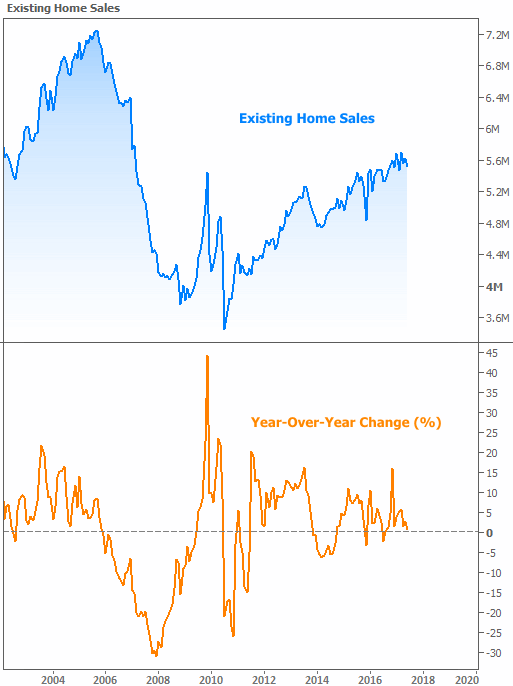Existing home sales slipped in June, with the blame again placed on low levels of inventory. The decline in sales, announced on Monday by the National Association of Realtors® (NAR), was anticipated, as pending home sales have decreased in each of the previous three months, ticking down by 0.8 percent in May.
NAR said sales of existing single-family houses, townhouses, condos and cooperative apartments were down 1.8 percent in June, to a seasonally adjusted annual rate of 5.52 million units, the second slowest performance of the year. The seasonally adjusted level in May was 5.62 million units. June just managed to stay ahead of the sales pace in June 2016, bettering it by 0.7 percent. Only the Midwest saw an increase in sales compared to May.
Analysts polled by Econoday had expected the June rate of sales to fall between 5.500 and 5.690 million units. The consensus was 5.58 million.

Sales of single-family houses dipped 2.0 percent to a seasonally adjusted annual rate of 4.88 million from 4.98 million in May, remaining 0.6 percent higher than the 4.85 million pace a year ago. Existing condominium and co-op sales were unchanged from a month earlier at a seasonally adjusted annual rate of 640,000 units which is up 1.6 percent from the previous June.
Lawrence Yun, NAR chief economist, says the pullback in existing home sales in June reflected the lull in contract activity in March, April, and May. "Closings were down in most of the country last month because interested buyers are being tripped up by supply that remains stuck at a meager level and price growth that's straining their budget," he said. "The demand for buying a home is as strong as it has been since before the Great Recession. Listings in the affordable price range continue to be scooped up rapidly, but the severe housing shortages inflicting many markets are keeping a large segment of would-be buyers on the sidelines."
Yun added, "The good news is that sales are still running slightly above last year's pace despite these persistent market challenges."
The median existing-home price for all housing types in June was $263,800, up 6.5 percent from June 2016 ($247,600). This is a new peak price, surpassing the record set in May. June marked the 64th straight month of year-over-year gains.
The median existing single-family home price was $266,200 in June and the median existing condo price was $245,900. Those prices reflected annual increases of 6.6 percent and 6.5 percent respectively.
The number of available homes for sale slipped again during the month, down 0.5 percent from May to 1.96 million existing units. A year ago, the inventory was 2.11 million and it has now fallen year-over-year for 25 straight months. The unsold inventory is estimated at a 4.3-month supply at the current sales rate. A year ago there was a 4.6-month supply; NAR considers six months a "balanced" market.
The tight supply of homes continues to be reflected in short marketing period. Properties typically stayed on the market for 28 days in June, one day more than in May, but six days fewer than in June 2016. Short sales were on the market the longest at a median of 102 days in June, while foreclosures sold in 57 days and non-distressed homes took 27 days. Fifty-four percent of homes sold in June were on the market for less than a month.
"Prospective buyers who postponed their home search this spring because of limited inventory may have better luck as the summer winds down," said NAR President William E. Brown. "The pool of buyers this time of year typically begins to shrink as households with children have likely closed on a home before school starts. Inventory remains extremely tight, but patience may pay off in coming months for those looking to buy."
First-time buyers accounted for 32 percent of existing home sales in June, down from 33 percent the previous month and a year earlier, while individual investors purchased 13 percent, unchanged from a year ago. Fifty-six percent of investors paid cash for their purchases and cash sales made up 18 percent of total sales, down from 22 percent in May and in June 2016. It was the lowest share for cash transactions since June 2009.
"It's shaping up to be another year of below average sales to first-time buyers despite a healthy economy that continues to create jobs," said Yun. "Worsening supply and affordability conditions in many markets have unfortunately put a temporary hold on many aspiring buyers' dreams of owning a home this year."
Foreclosures made up 3 percent of sales and short sales 1 percent. The aggregate of distressed sales tied with last September as the lowest share in NAR's nine-year tracking history.
Sales in the Midwest posted the only regional increase, rising 3.1 percent to an annual rate of 1.32 million, the same level as a year earlier. The median price in the Midwest was $213,000, up 7.7 percent from a year ago.
The Northeast saw a 2.6 percent decline in sales compared to May, an annual rate of 760,000, and 1.3 percent higher year-over-year. The median price was $296,300, an annual increase of 4.1 percent.
There was a 4.7 percent decline in sales in the South, to 2.23 million, unchanged from June 2016. The median price in the South was $231,300, up 6.2 percent from a year ago.
Existing-home sales in the West declined 0.8 percent to an annual rate of 1.21 million but remain 2.5 percent higher than last June. The median price in the West was $378,100, up 7.4 percent on an annual basis.







